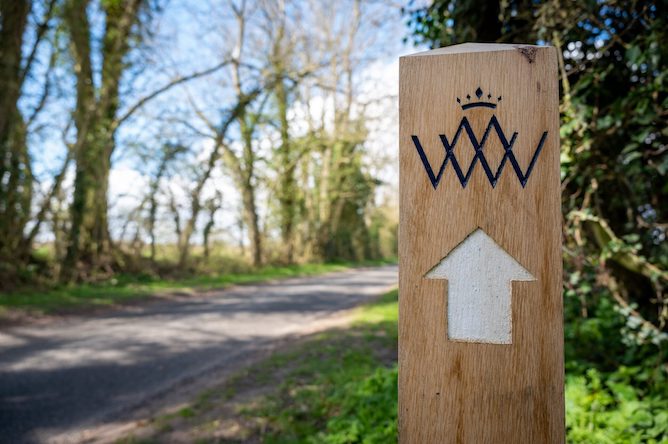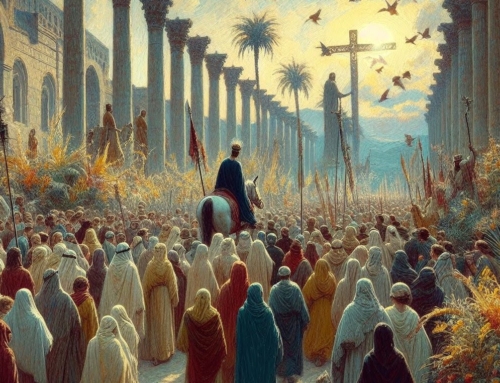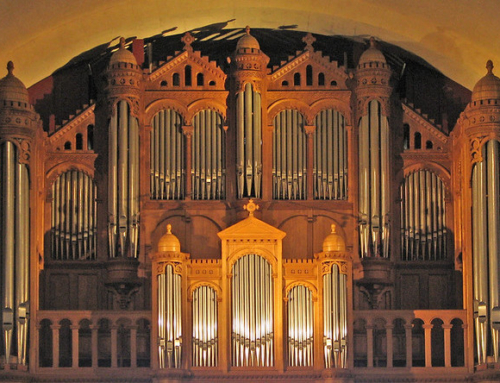This is part of a series entitled, “Pilgrimages: Paths We Tread.” Read the series introduction here. To see other posts in the series, click here.
Amid the vibrantly green and rolling hills of Norfolk, in the most easterly part of England, vestiges of an ancient pastime emerge along a pilgrimage route, one marked with pylons carrying a “WW” that guide the pilgrim along a 37-mile path of grassy lanes from the bustling city of Norwich to what was once the most popular pilgrimage destination in England. It was at the end of this path, the Walsingham Way, in 1061, that Our Lady appeared to a local noblewoman, Lady Richeldis, and asked her to build a model of her home in Nazareth as a shrine for local pilgrims. It would be a model of the same home where Gabriel announced the birth of the Savior at the Annunciation. Robert Pynson, the great fifteenth-century printer and poet, described the apparition in his marvelous masterpiece known as the “Pynson Ballad.” He writes in the fifth and sixth stanzas:
In spirit Our Lady to Nazareth her led
And showed her the place where Gabriel her greet:
“Lo daughter, consider” to her Our Lady said,
“Of this place take thou surely the mate,
Another like this at Walsingham though set
Unto my laud and singular honor;
All that me seek there shall find succor.
Where shall be had in a memory all
The great joy of my salutation.
First of my joys ground and original
Root of mankind’s gracious redemption.
When Gabriel gave to me relation
To be a mother through humility.
And God’s son conceive in virginity.”
And so Lady Richeldis ordered the building of “England’s Nazareth,” just as our Heavenly Mother described to the humble noblewoman. That house would become the shrine of Our Lady of Walsingham.
Waymarks now line the path from Norwich to Walsingham, passing along the ancient ruins of the mid-11th century Augustinian priory and the numerous small chapels that dot the landscape and direct the pilgrim toward the terminus. The fury of Henry VIII spelled the demise of the once-popular destination. In 1538 he sent his commissioners to break up the 400-year-old Augustinian monastery, loot it, kill the leadership, and destroy the buildings. They were highly effective: Henry’s henchmen destroyed the site so thoroughly that the only remaining significant structure standing today is the front façade of the monastery chapel.
It was amid these ruins when I finally recognized the mystique for which the English countryside has long been known. I walked the same well worn paths that Henry III did in 1241, arriving at the main site with thousands of my fellow pilgrims, all of us seeking the blessing of the Virgin Mary. It so happened that I had chanced upon the site on the same day as the national Indian Catholic Pilgrimage. Amid a sea of traditionally bright and colorful clothes, welcoming and happy faces, and the smell of delicious food wafting over the hills, I could see off in the distance a stone chapel, and through its open door, the outlines of a famous statue.
That stone chapel was the Slipper Chapel, returned to the Catholic Church in 1896 and restored in the ensuing years. As you approach the chapel, it is traditional to remove your shoes (hence the name, “Slipper Chapel”), just as Moses took off his shoes when he approached Mt. Zion. This is holy ground.
The Slipper Chapel traditionally marked the “Holy Mile,” the beginning of a mile-long path that once began the home stretch to the Nazareth House. Nowadays, the Slipper Chapel is the center of the Catholic Shrine and Basilica, and when you enter it, a glorious panoply of colors presents itself to the pilgrim. With the stained-glass windows spreading beams of red, green, and blue all over the chapel, you still can’t help but be struck by the magnificent and iconic statue of Our Lady to the left of the altar. She is seated on her throne with Christ on her left knee.
When Henry VIII ordered the destruction of the shrine, the original statue was taken to London and burned. What did it look like? Scholars had no idea until 1922, when Fr. Hope Patten, the Catholic parish priest of St. Mary in Walsingham, found a medieval seal used by the Augustinian Friars of the Walsingham Priory. On the seal is an image of the statue! Somehow this gold seal survived the Reformation and provided the basis to recreate the statue that had once stood in the shrine, the same image known so well throughout England and the world today. Our Lady sits upon an elegant wooden throne—the seat of wisdom—with her son, the Lord, crowned in glory, seated upon her lap and holding the book of the Gospels. Christ raises his hand in blessing toward the lily of virginity in his mother’s hand, while she in turn gestures back toward Christ, reminding the pilgrims of the true prize for which they have traveled.
As the sun began to set on this incredible day, I looked up at the beautiful statue of Our Lady and asked her for the blessing that she promised to give to those who travel to England’s Nazareth. The Blessed Virgin invites us all to walk that trail, to trod in the footsteps of the saints, and to come to know Christ our Savior in a unique way, and she stands on guard to intercede for us whenever we ask (see John 14:13). As the Ave Maris Stella implores her, “Make our way secure till we find in Jesus joy for evermore.”
✠
Image: Photograph by Bill Smith, Walsingham Way







